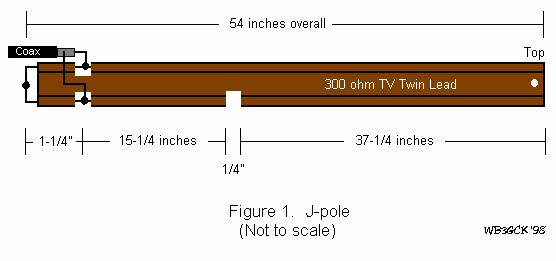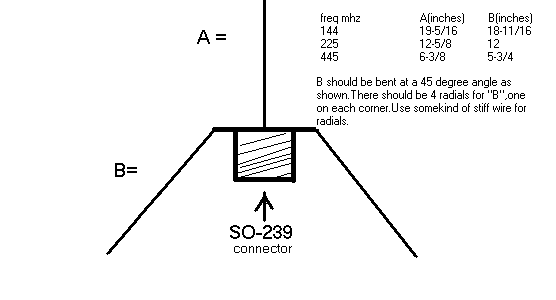
*Ham Radio Antennas *
By WAB
Do it yourself antennas
There has been quite a lot of interest in communications. What everyone needs to realize is that the antenna is the heart of any communication system. You can have a $100,000,000.00 radio set and a cheapy antenna,this will work so-so. You can have a cheapy radio set and a good quality antenna and it will out perform the expensive one anyday of the week.The same applies for any radio,whether it is a transceiver or just a receiver.
A properly tuned antenna is more crucial to transmitter performance than any other aspect of radio. The SWR (standing wave ratio) of the antenna is critical for transmitting. What that means is that the antenna is "balanced or tuned" for the frequency being transmitted. It is the difference between the power being radiated by the antenna and the power reflected back to the transmitter. The higher the SWR the harder the transmitter has to work to get the signal out of the antenna. This is why having a "tuned" antenna is crucial. Besides not getting the signal out,heat will build up in the transmitter and destroy the output transistors,thus ruining your transmitter.
Another aspect of "getting the signal out" is antenna placement. This another crucial step.The higher the antenna is the better it will work. An antenna at 50ft will work better than one at 10ft.Also an antenna under power lines (unsafe anyway) or close to metal structures,buildings and such,will be affected as well. As a usual thing,the higher the better and the more unobstructed the better.
Antenna safety cannot be stressed too much. STAY AWAY FROM POWER LINES!!!!!!!! Also grounding will help your antenna to work better as well as lightning protection. It is always a good practice to disconnect your antenna and move the cable away from the radio. Lightning will jump!! It donít take much to ruin a radio. Static electricity has messed up quite a few radios. Donít forget to unplug power supply too.
With the properly constructed and tuned antenna you wont need to have a 50,000 watt transmitter to be heard. But on the other hand,5 watts will go further than Ĺ watt,50 watts will go further than 5 watts.You rarely need over 100 watts to be heard 50 miles away. Radioís that operate on 144-500 mhz (vhf,uhf) are considered short range communications. HF equipment (1-30 mhz) is for long range communication which will be discussed in another article.
There are a lot of antennas out there. They are made numerous ways. This article is for homemade antennas. I will show you how to make a few simple antennas that will get you started and save you money. Tryíem and have fun!
Emergency J-Pole Antenna
This one is a great emergency antenna that you can roll up and keep in you BOB or pocket. I made a few and tried them out. You couldnít ask for a better one.

This is made from the old flat TV antenna wire. Donít use the foam filled one,just the cheap plastic kind. Solder the very bottom two of the two conductors in the TV wire as shown. Solder a piece of black RG-58 coax to the bottom of the antenna as shown. You can get it from Radio Shack. I put a 50ft piece on mine. Add about 50ft of some kind of cord attached to the top. Solder a PL-259 connector on the end of the coax. You can get these and the adapter for your walky-talky there as well. Just pull it out,throw the cord over a limb, pull it up and go to talking.
You can also use this antenna at home too.I put one inside of a piece of 1in. pvc pipe.This is to keep it standing up.Then put it in a tree or on top of your house.
If you follow the directions,you will not have a problem with this one.It will be tuned perfectly.
Base Antenna
This is a simple ground plane antenna that works well as a base antenna.Follow directions and youíll have no problems.You can use any stiff wire for the radials.I have used coat hangers and electric fence wire.

Use this formula to get exact measurements for the frequency you are using.
234/freq(mhz)X12=length in inches
The ground radials should be 5% shorter. All parts should be found at Radio Shack.
There are numerous antenna designs out there. These are only two omni-directional antennas. You can build all kinds. But this article is concerned with expedient antennas that can be used for travel or home use. Either one can be used for emergencies but the j-pole antenna would be easier to handle and take care of while on the move.
Receiver Antennas
An antenna for the shortwave receivers can be made by constructing a "longwire" antenna. There is no restriction on the length of it,the longer the better. Get a piece of small guage insulated wire and string out across the yard. I have used the 22ga.,shellac insulated transformer wire from Radio Shack. It comes in a 50ft roll. This wire is very easy to conceal because it is so small. There are numerous ways to put it up but I found that if you string it in an "L" configuration this is capable of receiving signals from all directions.Run one end to your receiver and attach it to the antenna.You can put an alligator clip on the end or just twist it to the end of the antenna of your receiver.This kind of antenna does not need to be tuned.You are not transmitting on it.This will greatly improve the reception of your receiver.
Have fun and try these antennas. As you already know,"Practice Makes Perfect".
WAB
All materials at this site not otherwise credited are Copyright (c) 1996-2001 Trip Williams. All rights reserved. May be reproduced for personal use only. Use of any material contained herein is subject to stated terms or written permis